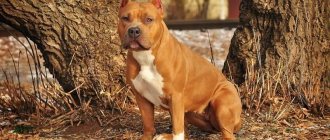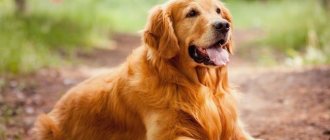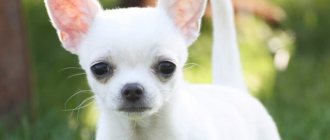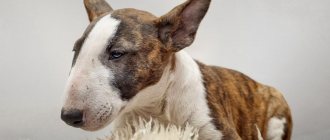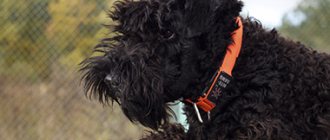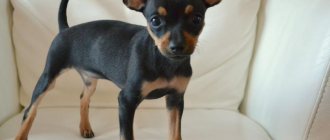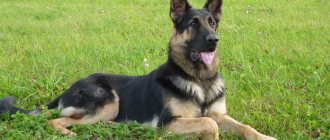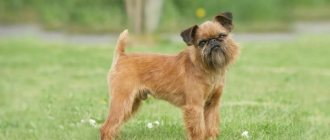- home
- Dogs
- Features of caring for small staffs and older dogs
Staff is a dog that appeared in our country relatively recently. Despite its rather dangerous and bloodthirsty reputation, the American Staffordshire Terrier immediately gained great popularity among both professional breeders and ordinary dog lovers. The reason for such a wide distribution of animals lies far from their fighting nature. Contrary to popular misconceptions, the breed is perfect for home keeping and guarding. An intelligent, sensitive, kind four-legged pet is ideal for families with children.
Staff is a dog that appeared in our country relatively recently.
History of the American Staffordshire Terrier breed
American Staffordshire Terrier
The desire to see cruel and bloody scenes has been observed in humans since time immemorial. The medieval English were no exception, who loved to have fun by staging dog fights with bulls, bears and wild boars. Most often, bulldogs and mastiffs were used for these purposes. The problem was that the dogs of these breeds were very large and not agile enough, which is why they often died from the blows of the hooves or horns of angry opponents.
The desire to “modernize” the dogs’ fighting qualities forced the owners to engage in breeding work. Terriers turned out to be the best candidates for crossing with bulldogs: the dogs are active, agile and, most importantly, very smart. Thus, at the very beginning of the 19th century, bull terriers appeared that perfectly combined the best features of their predecessor breeds. After the ban on bullfighting, which the English Parliament passed in 1835, dog fighting came into fashion, and the successful “terrierization” of the breed made it possible to obtain a phenotype that was perfectly suited for this purpose. Variants of the name of the breed - Staffordshire Terrier, Pit Bull Terrier - were gradually transformed and consolidated in the single name of the English branch "Staffordshire Bull Terrier".
English migrants who rushed to America after the North's victory over the South in the Civil War brought a large number of animals to the continent. Brutal dog fighting, which by this time had already been prohibited on the islands of Foggy Albion, gained particular popularity in the New World. The main direction of breeding work remained the development and consolidation of the fighting qualities of dogs. The United Kennel Club, created at the very end of the 19th century in the state of Michigan, chose the development and improvement of the pit bull terrier breed as its main activity. The dogs bred here not only took part in battles, but were also successfully used to protect houses, farms, and hunt wolves.
American Staffordshire Terrier puppy
At the same time, the voices of those animal lovers who did not share the passion for dog fighting and paid more attention to exhibition work were heard louder and louder. They set about developing a standard and improving the appearance of the pit bull. As a result, a dog was obtained that looked very similar to a pit bull terrier, but was quite suitable for a “peaceful life.” They called it the Staffordshire Terrier, and it was under this name that the breed was recognized by the American Kennel Club in 1936. This led to the division of breeders into two camps. Some registered their pets exclusively as fighting American pit bulls, others gave preference to Staffordshire terriers and did not recognize pit bull terriers at all.
FCI officially registered Amstaffs in its registry under number 286 in May 1971. The following year, the American Kennel Club changed the name of the breed to “American Staffordshire Terrier,” emphasizing that the branches have certain differences - the “American” is on average 8 cm taller at the withers and 5 kg heavier than the “Englishman”.
The first Amstaffs came to Russia in the 80s of the last century and very quickly gained popularity. High demand led to the fact that unscrupulous breeders did not bother to control either the appearance of the resulting dogs or their mental stability. This is precisely the reason why Staffordshire Terriers began to be considered “killer dogs”. Such a bad reputation lies entirely on the conscience of the owners, who either through stupidity and inability, or deliberately raised aggressive and ferocious dogs. Today the trend has changed, Staffords confidently occupy the niche of companion dogs.
Dog character
Staff is a smart and good-natured dog. Despite his rather intimidating appearance, sudden outbursts of aggression are completely atypical for him. The dog simply adores small children. She is optimally suited for large families and will become a loyal, devoted and reliable friend. However, only proper upbringing and care will help the dog show its best qualities.
The long history of Staffordshire Terriers dates back to distant England, where the ancestors of this breed, the English Bulldogs, grew up.
There are several characteristic breed traits that owners should be aware of.
- Staffs are very obedient and easy to train. The dog easily remembers what pranks are acceptable in the house, and what is strictly prohibited. Training an animal is absolutely easy. Even a child over 10 years old can easily cope with this task, but only under the close supervision of adults. Even small puppies quickly get used to obedience. For this quality they are highly valued and are often recruited to work in search and rescue services. It is representatives of this breed that become the best guides and rescuers. These dogs earned universal love during the rescue operation in Nord-Ost. With their help, specialists inspected objects before the assault began.
- Activity is another key quality of pets. They simply love having fun and cannot imagine their life without running, long walks and jumping. The more time the owner is willing to devote to the dog and the more games he offers it, the better. Staffords are absolutely not suitable for homebodies. If the dog does not expend his seething energy on a walk, he will definitely splash it out at home, causing serious damage. Therefore, it is extremely important to find time for long walks and games.
- Many people believe that the Staffordshire Terrier has an aggressive nature and is not averse to feasting on strangers. In fact, this is completely not true: the breed is very social, dogs love when their owners greet guests and adore children. Pets condescendingly tolerate all the tricks and pranks of younger family members, play with them with pleasure and even act as nannies. Staffs are no less friendly towards other four-legged animals they meet on a walk.
Staff is a smart and good-natured dog
Experienced dog breeders unanimously claim that the breed itself is incredibly loyal, friendly, calm and peaceful. This dog poses no threat. But the owner who trains and gives commands to the pet is dangerous for those around her. The staff obeys the owner unquestioningly and, without hesitation, carries out any order.
The fighting nature of Staffordshire Terriers manifests itself exclusively in battle. The dog is extremely aggressive towards the enemy; it is simply impossible to control him here. Therefore, all individuals that at least once showed aggression and hatred towards humans were immediately removed from breeding. This was done not only for safety, but also so that during dog fights opponents could be pulled apart with bare hands without fear of getting hurt.
Amstaff appearance
American Staffordshire Terrier with undocked ears
The American Staffordshire Terrier is a strong dog with well-developed bones and pronounced athletic muscles.
The height of males at the withers is 46-48 cm, females - 43-46 cm. Body weight - 25-30 kg and 22-25 kg, respectively.
Head
Medium length, but very voluminous and wide. The skull is almost flat, wide between the ears, almost square in shape. The occipital protuberance is poorly expressed. The transition from the muzzle to the slightly convex forehead is clearly visible. The muzzle is of medium length, the ratio to the length of the skull is 1:1. The chewing, buccal and parietal muscles are prominent and dense. The lips cover the jaws, but do not look saggy.
Nose
The lobe is black, rather large in size with well-opened nostrils.
Jaws
The jaws of the American Staffordshire Terrier are very powerful, strong, and dense.
Ears
Located high and wide. Amstaffs have options for both sharply and short-cropped ears and undocked ears. The latter option is rated higher if the shells are naturally short and stand very firmly on the cartilage (the so-called “rose”).
Eyes
Set low and wide apart, round in shape. The color of the iris is dark. Eyelids are pigmented.
Teeth
The American Staffordshire Terrier's teeth are large and white. The incisors on the lower jaw are arranged linearly. Scissor bite.
Neck
Strong, with well-developed muscles, expanding evenly towards the withers. Length – average. No folds or sagging are observed.
American Staffordshire Terrier muzzle
Withers
The Amstaff's withers are clearly defined, muscular, with a smooth transition into the line of the back. The shoulder blades are long, pressed to the back.
Back
Running amstaff
Short, straight, the line slopes slightly towards the croup. The muscles are well developed.
Croup
Slightly sloping, moderately rounded. Wide and muscular.
Rib cage
Wide and deep, rounded ribs.
Tail
The Amstaff's tail is straight and short. Set low, slightly tapering towards the end. When excited, stands erect.
Limbs
The forelimbs, when viewed from the front, are parallel and straight, set wide apart. Moderate high anteriority is observed. The bones are powerful, the muscles are sculpted and athletic. The elbows look straight back and are pressed to the body.
The Amstaff's hind legs, when viewed from behind, are straight and parallel, with well-developed (but not excessive) muscles. The angles of the joints are well defined.
Paws
Arched, not large, round and collected.
Wool
amstaff at the exhibition
The American Staffordshire Terrier's coat is short, moderately thick, hard to the touch, and lies close to the body. Straight and shiny in appearance.
Color
Solid - from cream to black, but not white, as well as two-color, spotted, brindle or piebald. White markings are possible if they make up no more than 20% of the basic color tone of the Amstaff.
The gender of a dog is clearly manifested in its appearance.
Possible defects
Any deviations from the standard, depending on the degree of their severity, can be considered either shortcomings or defects.
Disqualifying faults for American Staffordshire Terriers include: cryptorchidism, flesh-colored nose, skewed lower jaw, undershot, deafness, long or docked tail, light eyes, and ambling.
Types of purchase
Depending on the place of purchase, you can make a purchase:
- In the nursery.
- According to an advertisement submitted by dog owners on the Internet or in a newspaper.
- From the breeder.
- At the pet market.
More expensive dogs are sold in kennels and breeders. But they are purebreds here. You can buy a Stafford for less at a pet market or through an ad.
Puppies of different classes are for sale. Therefore, you can buy a dog:
- Breeding class (animals of this category are suitable for professional breeding).
- Pet class (purchased as pets. May have deviations from standards).
- Show class (suitable for participation in exhibitions. They are purebred).
You can buy a puppy of different ages. Typically sellers offer:
- 1-2 months.
- Three months old.
- Four months old.
- Five months old.
- Six-month-old individuals.
1-2 month old puppies are more expensive, six-month old ones are cheaper.
Amstaff photo
Character of the American Staffordshire Terrier
If we talk about the character of the Amstaff, then there is hardly another breed of dog whose character would be described by such diverse, and sometimes completely opposite, epithets.
Amstaff with owner
Reliable, intelligent, loyal, endowed with a considerable amount of fun and even some playfulness, balanced and self-possessed - this is what lovers of the breed say about the Staffordshire. Aggressive and vicious - this is the assessment given by critics of the breed. But the latter character traits are associated in almost all cases with either inept or with education aimed at the formation of negative qualities.
Anyone who wants to have such an animal should firmly understand that the American Staffordshire Terrier is a very powerful dog with pronounced guard and fighting qualities. She will until the end protect not only the members of the family in which she lives, but also the integrity of the territory entrusted to her from any encroachment. With such inclinations, a properly raised Amstaff will show aggression only if it feels threatened from the outside. A dog's intuition is so strong that sometimes it seems that it reads the thoughts of your ill-wisher. The Staffordshire Terrier attacks very often without “declaring war.” Barking and growling are for weaklings. The dog fights until complete victory; it is almost impossible to stop him. In “peak” situations this is quite acceptable, but in everyday life such behavior can cause many problems, so proper education and skillful socialization of the dog are very important. By letting your puppy know that all members of your family are his friends, you will eventually get a loving, attentive and devoted friend.
Initially, one of the goals in developing the Staffordshire Terrier breed was to obtain a dog that was best suited to perform the function of family protector. People of all ages can easily find a common language with Amstaff. For children, the dog will become a gentle, attentive nanny who will patiently endure all the little ones’ pranks. But you still shouldn’t leave your dog alone with very young children.
In a calm home environment, the American Staffordshire Terrier can be the sweetest creature, trying in every possible way to amuse and please its owner. But the authority of the latter must be indisputable, and only a fairly experienced owner can cope with such a strong spirit and body dog. In order to control the Amstaff and manage his natural instincts, desire alone is not enough - you cannot do this without professional knowledge and skills.
American Staffordshire Terrier with cat
Amstaff walks with a child
Raising puppies
Staffordshire Terriers are mothers of many children. At one time, an Amstaff gives birth to 6 to 10 puppies. If you decide to get a four-legged pet of this breed, be sure to ask the breeder about its pedigree. You should also obtain information about the habits and feeding schedule, vaccinations, the character of the animal itself and its parents. If your pet has brothers and sisters from other litters, you should also ask about their habits. Particular attention should be paid to all this if you are going to take part in breed work and dog shows in the future.
Stafford puppies are incredibly active, playful and inquisitive. In order for their energy to go in the right direction, raising pets must be regular and consistent.
Breeders give several important recommendations for keeping a new family member.
- Typically, moving to a new home occurs in Staffordshire Terriers at 2 months. From the first day of life with its new owners, the dog must understand what can be done and what is strictly prohibited. All people living in the apartment must strictly follow the established rules. Otherwise, the animal will quickly become disillusioned with one owner and will seek loyalty from another.
- Staffies usually begin to change their baby teeth at 4 months. During this period, they scratch their jaws on everything that gets in their way, and they can chew off the owner’s important things. To prevent this from happening, you need to purchase special toys.
- Staff puppies must have their own place where they can rest and sleep peacefully. The sleeping area can be arranged in the hallway or the owner's room. It is important not to allow the animal to go to a person’s bed; then it will be extremely difficult to wean him from this habit.
- Despite the fact that the little dog is incredibly active, physical activity at a young age should be strictly dosed. Overwork can negatively affect your pet's health and lead to improper development of joints and skeletal bones.
- Only the owner should raise the animal. Outsiders are strictly prohibited from interfering in this process.
- After a walk, you need to wash the animal’s paws and carefully examine them for injuries and cuts.
- You can raise a baby only in commands, without shouting or assault. To scold an animal for disobedience, it is quite enough to speak to it in a stern voice.
- You can feed your little Staffordshire only after a walk. Active games and running on a full stomach can cause digestive problems and cause a sagging tummy. In addition, a well-fed puppy will get tired much faster and want to sleep.
- Bowls for food and drink must be on stands. Their height must be increased as the pet matures and grows.
- The puppy's daily diet should contain at least 30% protein food. Protein is the most important building material, which is especially necessary for a growing body.
In order for your little pet to always be healthy and cheerful, it is necessary not only to properly care for him, but also to get vaccinations in a timely manner. As a rule, the first vaccine is given to an animal at two months. Until this age, he is protected from diseases by immunity transmitted from his mother. 2 weeks before vaccination it is necessary to carry out deworming. A veterinarian will develop a detailed vaccination schedule. At about four months, the animal's teeth begin to change. If any vaccination falls during this time, it is better to reschedule it to avoid complications.
Education and training
The American Staffordshire Terrier is a dog whose upbringing and training should never be left to chance. From the very first day a puppy appears in your home, you need to clearly understand all the responsibility that you have taken upon yourself by getting this particular breed.
Got it!
The main thing at the first stage is to properly organize the socialization of the animal. You can start immediately after the end of the “vaccination quarantine”. Pay special attention to introducing your baby to other pets. A small nuance - for this purpose it is better to choose the most good-natured and affectionate pets (you probably know these in your yard or nearby). The puppy is very curious, and it is important that he only has pleasant memories from new acquaintances, since the fear he experiences will be remembered for a long time and will eventually develop into aggression. Surprisingly, a small Amstaff can even remember the breed of its offender. This is fraught with problems in the future.
Often, owners of Staffordshire Terriers, when raising a pet, resort to two extremes. They either allow everything or prohibit everything. Both are wrong. In the first case, when the dog grows up, you will look, to put it mildly, funny on walks with it. The sight of an owner trying in vain to restrain a powerful Amstaff that is tearing off the leash (even for peaceful purposes) is simply pitiful. In the second case, you will raise a coward. And from cowardice to anger there is only one step. And no one knows when your pet will do it.
Obviously, some people consider the American Staffordshire Terrier to be an unsafe dog. You must be prepared for the fact that during walks the reaction of passers-by may not always be adequate. Do not engage in arguments or explanations in a raised tone, the dog will sense your aggression and think that your opponent is dangerous. The consequences of such an assessment of the situation are not difficult to predict. The best way out is to pass by in compliance with all norms of peaceful coexistence.
Rope game
Otherwise, raising an Amstaff is not much different from interacting with dogs of other breeds. You need to do it from the very first day the baby arrives at home. The principle is very simple. It says: “What is possible is always possible; what is not allowed is not allowed under any circumstances.” What is good and what is bad must be explained patiently and persistently, but in no case using violence or punishment, without changing the rules of the game along the way.
Do not spoil your pet at least until you develop a stable behavioral stereotype in him.
Amstaffs are very smart and easy to train. The best results can be achieved by visiting special sites.
And the last thing: you don’t need to raise a monster out of a dog. It won’t make you cooler than “cool Walker.” Don't turn your pet into a tool for self-affirmation.
Amstaff care and maintenance
Where's my beer?
The Amstaff is an unpretentious dog, and following simple rules will allow you to avoid many problems or, at least, minimize them.
Starting from puppyhood, you must systematically, in a timely manner, carry out preventive measures to combat parasites. Treatment for fleas, ticks, and deworming are performed using special medications selected depending on the age and weight of your dog. Vaccination is another procedure that is extremely necessary and should never be neglected. Notes on all vaccinations must be included in the veterinary passport of the American Staffordshire Terrier.
Caring for an animal's fur is easy. For combing, a special brush is used, which not only removes dead hair, but also massages the skin well. For daily hygiene procedures, you can use wet wipes (preferably without fragrances and hypoallergenic) or simply wipe your pet with a clean towel soaked in water. But it is not recommended to bathe the American Staffordshire Terrier often. This can harm both your dog's skin and coat. Don't forget to use special gels and shampoos designed for this breed.
Trim your dog's nails monthly. Amstaffs do not really like to have their nails done, so it will be better if the owner carries out this manipulation. And you can’t trust a stranger to brush your teeth with a special brush either. Don't forget to keep your ears and nose clean. Dryness and cracks in this area indicate health problems in the dog.
The American Staffordshire Terrier is a fairly active dog by nature, so be prepared to spend plenty of time interacting with it.
Regarding feeding, a number of important points should be highlighted.
- A strong skeleton requires a high content of the “building material” of calcium in the food, so vitamins containing this element must be present in the diet of the Staffordshire Terrier.
- Meat should predominate in the menu, which can be given both boiled and raw. The use of exclusively dry food is not recommended.
- The amount of food should correspond to both the age and gender, as well as the physical condition of the dog.
- The Amstaff diet should include cottage cheese, milk, and boiled eggs. It is recommended to add vegetables to porridges and soups. Meat and bone meal and bones (not tubular ones) are useful.
- Puppies need to be fed especially well so that they actively gain muscle mass.
Amstaff walks with owner
Possible diseases and methods of treating them
Amstaffs are very hardy and strong, but, unfortunately, they are susceptible to most viral diseases. That is why they need to be vaccinated from childhood. The vaccination schedule is selected individually by the veterinarian.
In addition to weak immunity, such dogs have another weak point - the stomach. They often experience dysfunction of the digestive system, especially if they do not eat properly. Alarming symptoms:
- Weakness.
- Vomit.
- Loose stools or constipation.
- Whining.
- Pressing the paws towards the stomach.
A dog that is visibly ill should be hospitalized. If the degree of intoxication is low, the veterinarian will prescribe sorbents, which can be given at home according to the instructions.
Less commonly, Amstaffs are diagnosed with dysplasia or glaucoma. The owner of this strong and devoted pet must take responsible care of it and ensure that it does not get sick. Love your four-legged friends!
Health and Diseases of the American Staffordshire Terrier
The American Staffordshire Terrier is a breed characterized by good health. These dogs are active and resilient. However, there are a number of diseases to which they have some tendency.
Ear placement on an American Staffordshire Terrier puppy
First of all, we can talk about hip dysplasia. The problem is common to almost all large dogs. This does not mean that all Amstaffs suffer from dysplasia, since a lot depends on diet, intensity of physical activity, as well as genetic predisposition. When buying a puppy, ask the nursery about the heredity of your chosen one. Find out how often this disease occurred in his ancestors, what was its development. No one will say for sure whether your dog will get sick or not, but some rough forecast, based on the information received, can be made.
Bloating due to indigestion is another problem that occurs in American Staffordshire Terriers. By contacting a specialist, you will find out which foods need to be excluded from the diet (or, conversely, added) in order to normalize your pet’s metabolism. Proper nutrition will help avoid the difficulties associated with obesity.
Amstaffs can also be genetically transmitted to a tendency to allergic reactions to a variety of irritants. Most often this manifests itself as redness of the skin and severe itching. In most cases, it is possible to accurately determine the agent only in a veterinary clinic.
Eye diseases such as retinal atrophy and cataracts can also affect American Staffordshire Terriers.
Modern veterinary medicine makes it possible to cure or at least minimize the consequences of a very large number of diseases. It is only important to detect them in time. Carefully monitor the condition of your pet: what his coat looks like, whether his ears and eyes are clean, how active he is, whether he has a good appetite, whether there are any problems with the discharge of natural needs. It won’t require any extra effort, but it will definitely bring the desired effect.
Description and features
Very hardy, powerful, serious and strong-willed - all these words perfectly describe the American Staffordshire Terrier breed . It was bred by the British as a result of many years of experiments in crossing terriers with bulldogs.
In the 70s, the dog was brought to the USA, where it managed to win a huge number of fans. Even then they began to use it for the security service. It was noted that the Amstaff has good observation, strength and is capable of independent decision-making. All this made him not only an excellent watchman, but also a bodyguard.
It was easy to train him on some animals and even people. With an aggressive manner of training, the dog becomes angry. He is ready to attack a person if the owner so desires. It was this animal’s willingness to protect its owners that served as the reason for its official ban on the territory of some modern states, including America.
Amstaff is endowed with a natural sense of danger and is able to defend itself
Interesting ! In Russia, breeding Amstaff dogs was not banned for one reason - the Soviet actor Yuri Nikulin really liked the dog. It was he who insisted on the need for a population of representatives of the breed in these parts.
Many people, knowing about the fighting past of representatives of this breed, are wary and prejudiced towards them. In fact, such dogs cannot be called evil by nature. On the contrary, they are very sociable, friendly and well trained. But their terrifying appearance often frightens.
It has been proven in practice that with proper and consistent training, these dogs become not only protectors and bodyguards, but also assistants for the disabled. For example, some Stafford dogs serve as guide dogs for their blind owners, while others pull drowning people out of the water. Doesn't this prove that they are not the embodiment of evil at all?
These are not all the tasks for which such a dog is suitable. Amstaff is a rescuer, bodyguard, guide, but also a good friend who will always cheer up his owner in need of consolation. Moreover, some farmers still believe that there is no better breed for looking after livestock. Its representative will not be afraid of any predator, as he has a powerful physique and a fearless character. He will challenge anyone who encroaches on his master's property.
How to choose a puppy
Let’s make a reservation right away: if you want to buy a purebred Amstaff, then the options of the bird market or advertisements on the Internet are immediately and unconditionally dismissed.
The procedure for purchasing from a specialized nursery has been well established for a long time, and you should definitely be familiarized with it in detail, if, of course, we are talking about a place with a good reputation. In this case, it is important to know that when buying a dog it is better to enter into a formal contract. Sometimes the form of purchasing a puppy “under contract” offered to clients has a number of nuances that can infringe on the owner’s rights to both the dog itself and its future offspring.
The third option is to buy an American Staffordshire Terrier puppy yourself from an experienced and trusted breeder. In this case, experts recommend paying attention to the following points.
American Staffordshire Terrier puppy face
- When planning a show career for your dog, ask the owner of the bitch to give you the opportunity to observe the development of the babies. The Amstaff's future traits are best demonstrated at birth, on the third day of life and at the age of one month. It is unlikely that you will have time to see the baby on the first and third days, but the monthly period is worth studying more closely. It is at the age of thirty days that the small American Staffordshire Terrier is an exact miniature copy of what can grow out of it, subject to all the rules and conditions for raising dogs of this breed. Don’t take stories that the deficiencies visible at this age can be corrected with a massage, a special diet, or some kind of “dancing with tambourines.”
- American Staffordshire Terrier puppies, which have a lot of white in their color, may not have completely colored noses, eyelids and lips, but partial coloring should definitely be observed. This process is finally completed by 8 months of age (sometimes a little later). The color of the iris of the eyes acquires its final shade even later, so you need to be very attentive to the eyes of a soft blue color, especially if the puppy has a fawn-blue or red-blue coat color.
- The puppy's coat should be short, “velor”, without bald spots. Skin without ulcers and pustules.
- The ears should be clean, without any unpleasant odor. The eyes are clear, without signs of souring. Under the tail it is clean and dry.
- If you notice a small hernia during examination of your abdomen, do not be upset. This problem can be dealt with through simple procedures.
- A Staffordshire Terrier puppy at this age should weigh from 2.5 to 5 kg, look fairly well-fed, without protruding ribs or rumps. In addition to mother’s milk itself, the baby’s diet should already contain other dishes: kefir, cereal porridge, scraped meat, cottage cheese.
An interesting fact is that the bitch sometimes regurgitates recently eaten food to her puppies, and the kids happily pounce on such a treat. This is absolutely normal and is explained by natural instincts. Moreover, this behavior indicates a well-developed maternal instinct, which is highly likely to be inherited by all female puppies in this litter.
You are unlikely to buy the baby you like right away. The sale of an Amstaff is permitted after it reaches the age of 45 days and the owner of the bitch has completed the mandatory branding procedures and expert assessment. Your first visit to the nursery will be more of an informational nature, but it will not be superfluous to thoroughly prepare for it by collecting the maximum amount of information.
Brief description of the breed
The Staffordshire Terrier is suitable for hunting, guarding, and sports. This is a good friend and companion. The dog gets along well with children. It is distinguished by its devotion to its owner.
Description of the breed:
- The height of bitches reaches 44-45 cm, cables - 45-48 cm.
- An adult dog weighs from 25 to 30 kg.
- The dog is stately, looks strong and strong.
- The head is wide with distinct muscles.
- The eyes are small, deep-set, dark in color.
- The jaw is strong.
- The ears are cropped.
- The nose is colored black.
- The coat is shiny and short.
- The neck is massive and wide.
- The front legs are strong and widely spaced, of medium size.
- The gait is springy.
Staffordshire Terriers come in the following colors:
- Blue.
- Black.
- Redheads.
- Fawn.
- White with black spots.
- Blue-fawn.
- Red with a dark tint.
- Black and tan.
According to the standards, any solid color, spotting and particolor are allowed. White color should not occupy more than 80% of the entire body. Pure white and liver-colored individuals do not fit Stafford standards.
Dogs of this breed have a gentle and good-natured character. They are not homebodies, they love walks and movement. They become very attached to their owner and do not like to be alone.
Photos of Amstaff puppies
How much does an American Staffordshire Terrier cost?
Like most other dog breeds, the cost of an Amstaff puppy directly depends on which class it belongs to.
Prices for show-class animals that have good makings for a successful exhibition career range from 25,000 - 35,000 rubles and above. The gradation in this case is associated with the eminence of the parents, as well as the personal inclinations of the puppy, the degree of expression of the best traits of the breed.
Representatives of the breed class are cheaper - 18,000 - 25,000 rubles. These American Staffordshire Terrier puppies meet breed standards or have minor deficiencies. They are unlikely to become champions, but they are quite suitable for breeding.
Pit class is the cheapest. Prices range from 12,000 to 18,000 rubles. If you do not plan to become a breeder or spend time and money preparing your dog for championship shows, but just want to have a reliable friend and protector, the pit-class American Staffordshire Terrier will be the right choice.
In any case, no matter which puppy you choose, the responsibility for its happy future lies entirely with you.
Nutrition
The American Staffordshire Terrier in the photo looks very strong and courageous, firstly, because breeders created it that way, and secondly, because of good nutrition. When a person feeds his purebred dog correctly, a shine appears on its coat (an indicator of good absorption of vitamins by the body), muscles acquire a clear outline, the skeleton becomes stronger, etc. All this is the result of the animal’s daily absorption of minerals, vitamins and all nutrients necessary for maintaining good shape and health.
Let us immediately note that Amstaffs are prone to rapid weight gain, so they should never be overfed. The main food of a young dog is boiled offal (kidneys, lungs, hearts, etc.). Cow's stomach is very beneficial for dogs. It is better to make minced meat from it. But be sure to keep in mind that when cooked it releases a stench.
It is also advisable to give him 200 to 300 grams of raw chicken every day. Meat contains amino acids necessary for the dog to fully develop. In addition, give him baked apples, raw carrots and cabbage, broccoli, whole grain bread, dairy cereals and pasta, and bone cartilage.
It is better to switch Amstaff to dry food at 1 year of age. During this time, he will grow enough and form. It is not necessary to stop feeding him food from your table at this stage. But there are foods that he is not recommended to consume:
- Fish with bones.
- Smoked meat.
- Sharp tubular bones.
- Chocolate.
- Caramel candies.
- Delicious baked goods.
